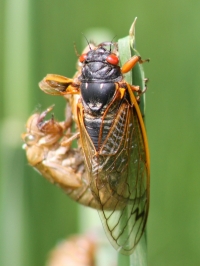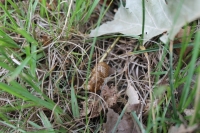






Though present in swarms only a few miles away, 17-year cicadas have proven scarce in the Heights area.
“We haven’t seen them in any quantity,” says Sarah Cech, Natural Resources Manager for the Nature Center at Shaker Lakes.
The few cicadas that call the Heights home have mostly revealed themselves by trace evidence: a wing here, a shed exoskeleton there. “I haven’t seen any whole cicadas,” Cech confesses. “We’ve seen antennae, wings, and a few parts here [at the Shaker Lakes Nature Center].”
My own, life-long quest for 17-year cicadas in my neighborhood has yielded similarly scanty results. In my childhood searches of my neighborhood during the last cicada emergence in 1999, I came up empty-handed. For 2016, I was determined to do a little better.
During the cicadas’ brief appearance in Northeast Ohio in May and June, I undertook daily backyard safaris. I pounded the pavement in every park and public space in the 44118 zip code. No dog-walking session was complete without trying to catch a hint of the bugs’ tell-tale, two-tone love song. I struck out in Forest Hill, Cumberland, Oakwood Preserve and Caledonia parks. By the end of June, the best evidence I’d been able to turn up was a single wing from Cain Park.
Then one day, during a Sunday barbecue, my Dad mentioned in an off-hand way that he’d spotted a cicada wing in Horseshoe Lake Park while cleaning up after his dog. I insisted that he show me the spot immediately.
It turns out that Horseshoe Lake Park just might be the garden spot for 17-year cicadas in the Heights area. The giant oak trees near the Park Drive parking triangle sported a few dozen shed exoskeletons, and the forest floor was perforated with the cicadas’ emergence tunnels, each the width of a baby carrot. The littered wings left at the scene hint that the inhabitants are from the species Magicicada septendecim, the same red-eyed beauties that emerged in such abundance elsewhere.
Why are 17-year cicadas so rare in the Heights? In part, it’s due to the bugs limited ability to spread to new areas. Most live their entire lives within 100 yards of where they were born.
However, it’s more likely that they simply haven’t survived the area’s transformation over the past two centuries. “It could be because this area was farmed extensively in the 1800s,” Cech says, “or the amount of pavement.” Pavement, after all, prevents newborns from tunneling down to tree roots and keeps full-grown adults from making it back to the surface.
Personally, I can’t wait to see if the cicadas in Horseshoe Lake Park can stick it out for another 17 years.
—Chris Mentrek [The author is a naturalist for the Geauga Park District who grew up in University Heights, and now lives in Cleveland Heights.]



Leave a Reply